
The Kits Are Alright!
By George Guidoni, Editor; Photos by Darrel Munro
Automation Design & Innovation Food Safety General Sustainability Corrugated Film Metal DetectionEast Coast salmon processor poised to make big waves in the frozen seafood market through leading-edge product innovation and tasteful packaging execution —May 2018, Canadian Packaging
Urging North American consumers to eat more fish and seafood instead of red meat is in many ways like encouraging them to consume more veggies—a sound advice based on a wealth of nutritional evidence that, for many reasons, often falls on deaf ears.
With today’s budget-conscious consumers constantly looking to save pennies and stretch their dollars in a daily quest to keep up with the rising costs of living, seafood is simply not the first thing that comes to mind for shoppers trying to keep their food costs in line.
For a large portion of these consumers, seafood is for the most part normally perceived as a special-occasion luxury item rather than a daily staple, with the prices to prove it.
Moreover, the widespread notion that making a high-quality seafood dish requires an inordinate amount of time, preparation and culinary expertise to pull it off is also a major obstacle to more robust seafood consumption.
Valid concern or not, the onus is ultimately on seafood producers themselves to make their products more accessible to the masses, according to Doug Park, founder and chief executive officer of the thriving, hard-working, and highly innovative Nova Scotia seafood processor Cedar Bay Grilling Company.
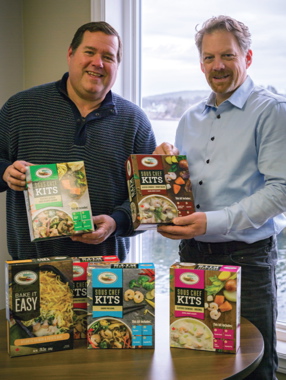
Having played an instrumental role in the development of the brand new line of easy-to-make Sous Chef Kits brand of frozen seafood entrees, Cedar Bay Grilling Company’s general manager Robert Moore (left) joins the company’s founder and chief executive officer Doug Park in showing off the attractive colorful paperboard cartons, designed by Balance Creative, that are expected to start retailing across Canada at leading grocers by the early fall of this year.
Tucked away in a tiny South Shore hamlet and fishing village of Blandford, about an hour’s drive south of Halifax, the 16,000-square-foot processing and packaging facility is a veritable hotbed of seafood innovation guided by a single-minded quest to make seafood a rewarding, convenient and consumer-friendly experience with affordable, high-quality products designed to enable any home cook to prepare a delicious, gourmet-quality fish or seafood recipe without breaking a sweat.
Having established itself as a notable industry player in recent years with a very successful line of Cedar Planked Atlantic Salmon products—sold in airtight vacuum packs containing ready-to-cook salmon fillets and pre-soaked cedar planks—the 40-employee company is now pushing itself on to the next level of innovation brilliance.
Scheduled for a major retail launch across Canada in early September, the new line of Cedar Bay Sous Chef Kits are unlike anything everyday seafood lovers have seen in their supermarket freezers to date, as evidenced by the product’s selection as one of 10 finalists in the Best New Product competition of the recent Seafood Expo North America exhibition in Boston, Ma.
With Cedar Bay brand products already retailing at all major Canadian grocers and at seven of the top 10 U.S. chains, according to Park, the attractive, colorful boxes of Sous Chef Kits—currently consisting of five mouth-watering recipes—are a testament to the company’s genuine commitment to product and packaging innovation.
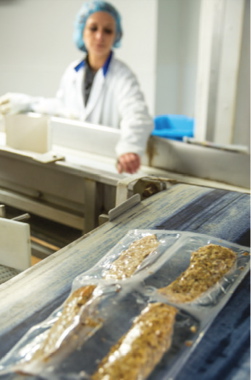
A freshly vacuum-packed four-pack of breaded salmon fillets coming off one of the plant’s two high-performance Variovac Optimus machines supplied by Reiser Canada.
“Our retail customers love us because we always bring innovation to the table,” Park told Canadian Packaging in an interview from the company’s recently-opened U.S. subsidiary in Miami, Fla.
“It all about challenging ourselves to solving problems for consumers.”
As Park relates, the original inspiration for the kits came from an intense collective brainstorming session about a year ago, when Cedar Bay employees and a few professional chefs were challenged to come up with ideas for a new product line that was not only unique in the market, but could also be produced cost-effectively on the company’s existing equipment.
“That’s where the idea of a multi-component kit came about,” Park recalls.
“There are a lot of consumers out there who feel they do not have the right skillset to make a proper seafood dish, but the kit concept eliminates that fear factor,” Park says.
“Each kit has four individually-packed components with clear instructions on how to use it in that particular dish, which engages the consumer to participate in the creation of their meal and, critically, always obtain a good result.”
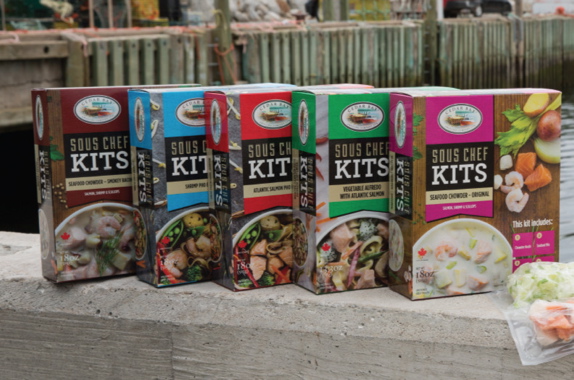
Each of the five different Sous Chef Kits recipes contain very generous servings of high-quality seafood and other ingredients to provide a nourishing and delicious meal for two adults at a highly attractive price point of under $10 per box.
According to Park, the kits offer a perfect meal solution for young busy professionals who lack extensive cooking skills, as well as the empty-nesters who will appreciate the portion control aspect of the Sous Chef Kit recipes.
The new kit line currently comprises five different recipes—including Atlantic Salmon Pho, Shrimp Pho Bowl, Vegetable Alfredo with Atlantic Salmon and two varieties of Seafood Chowder (Original and Smokey Bacon)—that were picked from more than a dozen inspired suggestions, according to Park.
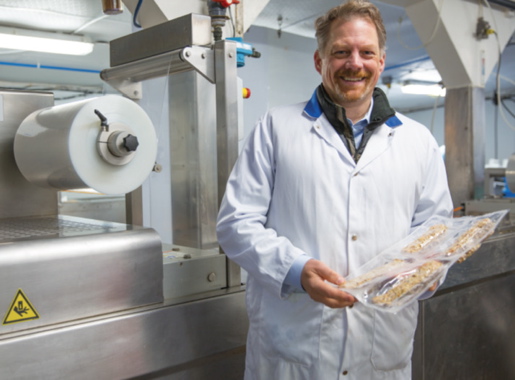
Cedar Bay Grilling founder and chief executive officer Doug Park says he loves everything about the versatile, user-friendly and high-performance Variovac Optimus vacuum-packaging machines (background) installed at the company’s Blandford processing facility, noting that they play a key role in enabling the company to develop innovative and affordable seafood meal solutions for Canadian and U.S. customers with exceptionally quick time-to-market.
In addition to the sensory appeal of the dishes themselves, the ease-of-preparation was also an important selection criterion, Park relates.
“To make the Shrimp Pho dish, for example, you take out the packages of broth concentrate, mix it with two cups of water and bring to boil, add the packet of shrimp, bring it all to a simmer, and add the vegetables packet at the last minute so that they’re warm but still crunchy,” Park explains.
“You then place the kit’s rice noodles into the two pockets of the bowl supplied in the kit and pour the broth with shrimp and veggies over them, which heats up the noodles and completes the dish.”
It’s a very similar prep process with the two chowders, Park explains, except the noodles are replaced with pre-diced potatoes and the protein comes in the form of shrimps, scallops and salmon chunks—each in their own vacuum-packed pouches.
“It’s really a ‘paint by numbers’ approach to seafood cooking that is impossible to mess up if you follow the directions,” Park extols, complimenting the outstanding package design graphics developed for the kits through a collaborative effort by a package design agency Balance Creative, and Cedar Bay’s in-house deign team lead by Doug’s wife Barb.
“It is really hard work to get a message across on a billboard this small,” he says, “and we actually had two messages to relay: what’s in the box and just how easy the product is to make.
“It took multiple go-arounds to get it right,” he recalls, “but the team worked relentlessly, full-tilt, to get it right.
“Full credit to them for simplifying what we wanted to convey to the consumers: These kit dishes can be made in under 20 minutes, using just one pan, to make enough delicious and healthy food for two adult servings.”
Remarkably, all the kits are priced under $10 apiece, Park points out, making them affordable for even the most modest household budgets.

A close-up view (left) of the four-portion pack of German Pretzel Encrusted Atlantic Salmon packed inside tightly sealed freezer bags printed and converted by Farnell Packaging Limited and supplied to the plant by Veritiv Canada, along with the high-quality corrugated display boxes (right) manufactured by Maritime Paper Products.
“We are very generous with our portions: there is no skimping or short-changing consumers with the protein or any other ingredients,” Park says.
“When someone uses one of these kits to make a meal, they will see a lot of value-added in it.
“With our chowders, the consumer will actually be able to see, make out and taste the individual shrimps, scallops and chunks of salmon and enjoy their distinct textures and taste profiles—it’s not just a glob of stuff held together by creamy liquid.
“We want to satisfy consumers to the max with these products,” says Park, citing 18-month frozen shelf-life for each of the five Sous Chef Kit recipes.
While salmon still accounts for the lion’s share of processing at Cedar Bay Grilling, as well as the bulk of about 25 different SKU’s (stock-keeping units) produced over the one-shift, five-days-a-week work schedule, Park says that adding other seafood species to the company’s repertoire can only strengthen its overall processing and packaging expertise and core competencies.
“We don’t see a reason for intentionally limiting ourselves to just one type of seafood,” he states.
“In order to be able to market ourselves as a category innovator, we see great potential value in diversifying our game a little bit by developing more value-added solutions for the consumer.”
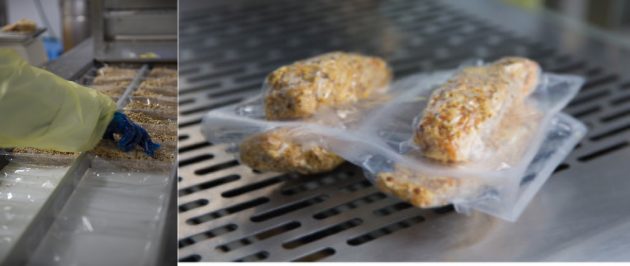
Pieces of breaded premium Atlantic salmon (left) being hand-placed into their proper compartments on top of the high-strength clear plastic film, manufactured by Winpak and supplied to the Blandford plant by Veritiv Canada, prior to being sealed into tidy four-packs (right) on the high-performance Variovac Optimus equipment purchased from Reiser Canada.
This mindset also applies to the salmon-only products, Park points out, citing the new Bake it Easy brand of frozen entrees containing generous chunks of seasoned Atlantic salmon placed in a cooking pan, and topped off with shredded potatoes, large pieces of broccoli and a zesty cream sauce.
“We’re starting with salmon, but we fully expect to extend this brand to other types of fish and seafood on by-request basis.”
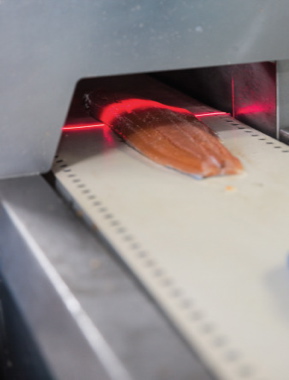
The Blandford facility uses a state-of-the-art Marel laser portion cutting machine to ensure superior portioning accuracy with virtually zero food waste.
In a similar vein, the company’s line of globally-inspired breaded frozen salmon fillets—such as the four-pack bags of German Pretzel Encrusted Atlantic Salmon—reflect virtually limitless capacity for imaginative product innovation.
“We have actually just completed an order for this product for one of the leading Club Store chains in the U.S.,” Park relates, “and we’re very hopeful on being able to bring it to the Canadian retail market soon.”
For now, however, the company’s primary marketing focus is to ensure a smooth and well-received national Canadian retail launch of the Sous Chef Kit product line this fall.
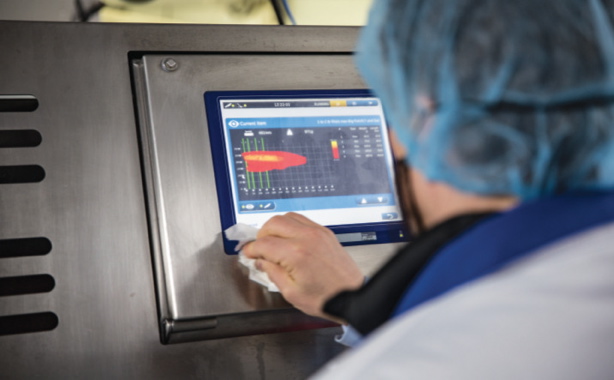
A touchscreen interface terminal provides a real-time graphic display of all the critical product data gathered by the unit’s high-speed vision systems incorporated inside the machine.
Some of the kit products are already being test-marketed down in the U.S. at selected retailers in and around Philadelphia, and Park says he is very encouraged by the positive feedback so far.
Says Park: “We got a lot of positive comments at the Boston seafood show about how innovative our kit products are, and also on just how good they taste.
“Seafood retailers and buyers are not an easy crowd to please,” Park notes. “Whenever a new product is introduced, there is always a suspicion that it will either taste lousy, be too salty, too expensive or whatever.
“With this product, we managed to hit all the marks on both taste and affordability.”
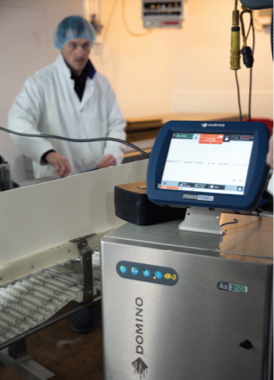
The Blandford facility makes exclusive use of the high-performance Domino product coding equipment, such as the model Ax 350i continuous inkjet coder above, for all its product identification and traceability requirements.
As Park relates, nearly all of the retail products produced at the Blandford plant are packaged on three high-performance Variovac Optimus vacuum-packing machines supplied to the plant by Reiser Canada, a subsidiary of Canton, Ma.-headquartered food processing and packaging equipment manufacturer Reiser.
“We got our first Variovac machine in 2012, purchased another two years later, and just got our third one earlier this year for the Miami plant,” says Park, adding he is extremely satisfied with the equipment’s performance, reliability, user-friendliness and flexibility.
“Almost everything we package goes through a Variovac machine,” he says. “They are real workhorses for us and we make full productive use of them.
“They are easily interchangeable machines, so we can use them to run any line of products at any one time with minimal disruption,” Park reveals, although he expects one of the Variovac units to be soon dedicated to the Sous Chef Kit production full-time as the launch date approaches.
“This is intended to be a very mainstream product for us, which I expect to provide a full workload for one of our Variovac machines during the busy fall and winter seasons, when people are not barbecuing as much.”
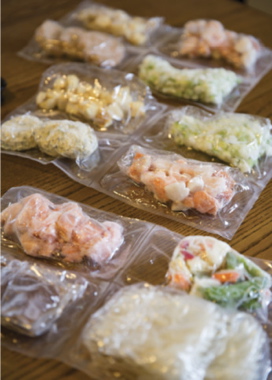
Packaged on the Variovac Optimus machines using high-barrier plastic film manufactured by Winpak, the Sous Chef Kits components offer 18-month product shelf-life.
Designed as a high-performance plug-and-play system solution for cost-effective food packaging automation, the compact Variovac Optimus machines feature stable stainless-steel construction, a state-of-the-art Variovac RapidAirSystem for optimal packaging precision and shaping; sanitary design; and robust packaging outputs of up to 13 cycles per minute.
Equally proficient at all the common sealing, vacuum-packing, MAP (modified–atmosphere packaging), skin-packing and shrink packaging techniques, the highly versatile machine can work with a vast range of film types and thicknesses to produce all manner of packages up to 110-mm in depth.
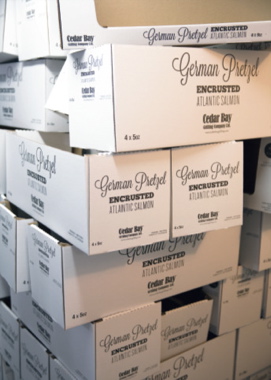
Maritime Paper Products is the primary supplier of corrugated display and shipping boxes used to get Cedar Bay products to market.
Park says he is very fond of the machine’s quick product changeovers and flexibility that allow Cedar Bay to “partially vacuum-pack” each individual kit component to ensure optimal product shelf-life and contents protection, with very gentle handling of the product itself.
“Reiser is a fantastic company to work with: their equipment is superb and their technicians are exceptionally knowledgeable people that fully understand their equipment as well as our production needs and demands—helping us maintain a very efficient production flow,” he acknowledges.
In fact, the Variovac equipment has performed so well at the Blandford plant that Park had no qualms about purchasing an additional Variovac machine, featuring advanced
skin-pack capabilities, for the company’s new 7,000-square-foot Miami operation started up earlier this year—specializing in planked fresh salmon products.
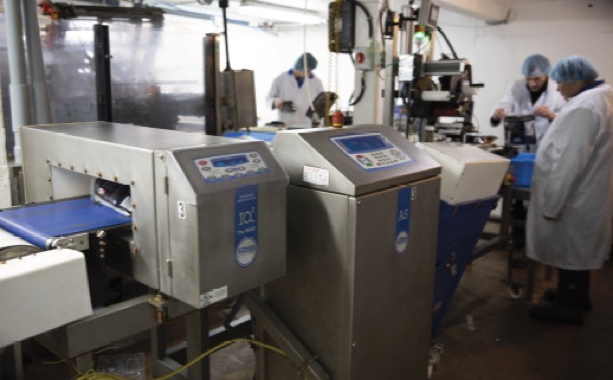
All finished packages are put through a Loma Systems combination metal detector and checkweigher system, comprising a model IQ2 metal detector and model AS checkweigher, as part of the strict food safety procedures that the Cedar Bay plant in Blandford has implemented as part of its globally-recognized BRC (British Retail Consortium) food safety certification, which the facility has maintained in flying colors for the past four years.
Park says the company takes a lot of pride in having maintained the coveted, internationally-recognized BRC (British Retail Council) certification for food safety at its Blandford plant for the past four years, achieving AA status for the last two years.
“It’s one of the highest food safety standards in the world, and because it started in Europe, we needed to obtain it in order to be able to sell in European markets one day,” he explains.
“It was a huge effort for our staff and required significant investment to put new systems in place to achieve compliance,” says Park, citing installation of Loma Systems metal detectors to inspect finished packages for any possible metal contamination.
“I am glad we made the effort to obtain BRC certification because now that it is starting to be applied in North America, we are in a very good position in terms of being ahead of the curve,” Park explains.
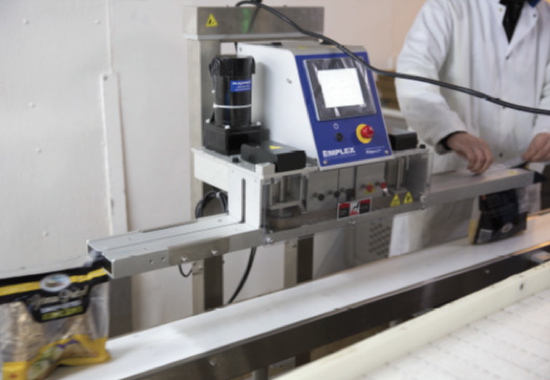
A line worker guides filled bags of breaded salmon through the modular Emplex bag and pouch sealing machine.
For all of the company’s market growth and penetration to date, Park is very level-headed and rational about the risk of getting ahead of himself by competing directly with the industry’s dominant players with far greater capital resources and market clout.
“What we try to do is carve out a niche with some specialty items that do not go head-to-head with the mass-produced brands,” he opines.
“In fact, rather than competing with other salmon producers, our planked salmon products are actually helping to drive the overall salmon volume up because we have created a whole new consumer event that wasn’t there before,” Park says.
“That said, in the big picture we are competing not only against other people’s salmon, but also against other seafood protein and other animal protein in general.
“That’s why our pricing has to be sharp, our logistics have to be tight, and our production equipment, like the Variovac Optimus machines we use, must be top-quality
stuff.”
As for logistics and warehousing, Park credits Veritiv Canada for providing superior service in looking after all of the company’s needs for packaging consumables—including folding cartons from RockTenn, corrugated containers from Maritime Paper Products Ltd. and plastic packaging films from Winpak, Ltd.—by serving the Blandford plant in true JIT (just-it-time) fashion from two distribution centers in Dartmouth, N.S., and Moncton, N.B. .
For all his enthusiasm about the pending launch of the Sous Chef Kit product across Canada, Park says he and his staff are already bouncing around ideas for further product innovation down the road.
“Let’s just say we already have some pretty good ideas in the hopper about what we could add to the kit products, as well as some other product lines,” Park says, citing speed-to-market as one of Cedar Bay’s critical core competencies.
“Once we decide on what we’re going to do, we move very fast to make it a reality,” he remarks.
“We only conceived the Sous Chef Kits last May,” Park points out, “and we were ready to go to market with them by January.
“That kind of turnaround is virtually unheard of in this industry,” Park concludes, “but it is a big part of our corporate culture and a big part of what makes our job so much fun for everyone working at Cedar Bay Grilling.”
